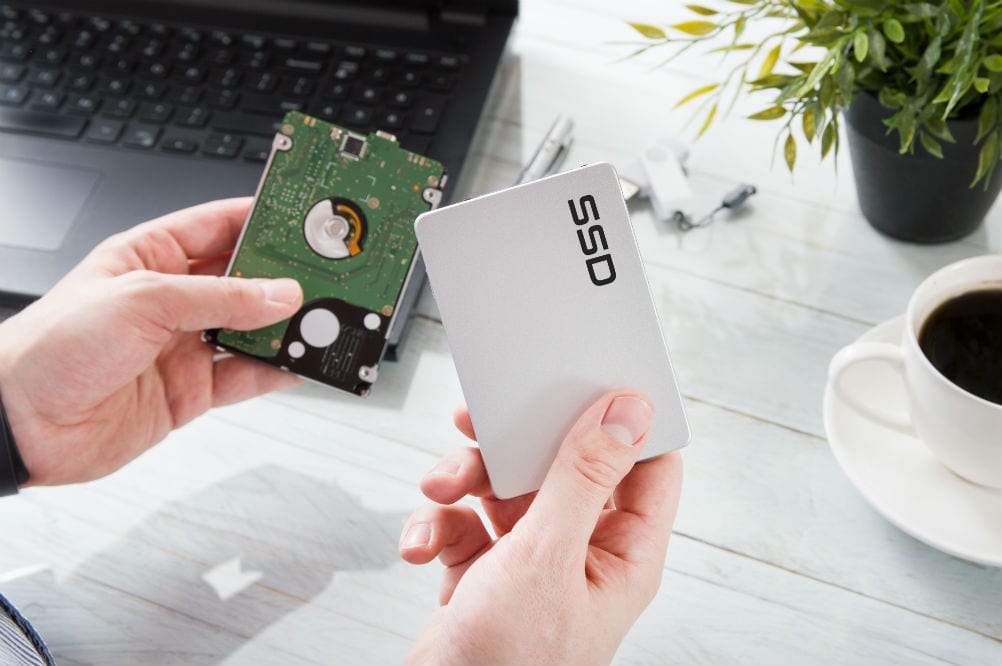If you are thinking of or wondering how to add SSD to your desktop computer (Solid State Disc), then there may be several reasons for doing so. An SSD will not only help make individual programs work quicker on your computer but it will also speed your computer's overall operating speed.
Hard Drive Basics
For those of you who may have heard about the advantages of an SSD but are unsure what they mean, here is a brief explanation. The main storage inside many computers is provided by their hard disk drive or HDD. These operate on the principle that the storage disk which stores this data spins at high speed and is read by a read/write head which is housed on a movable arm.
While these have been the mainstay of computers for many years, they have the disadvantage of effectively being a mechanical device, and therefore ultimately prone to faults along with a relatively limited life. As our use of computers has expanded in terms of what we need them to do, there are also some issues with regards to their speed, the amount of power they require, and the noise they make also annoys many users.
SSD versus HDD
The alternative is an SSD which consists of one or more memory chips which store the data, as opposed to a disk. This means there are no moving parts to break down, and while SSDs cannot be described as immortal, they will undoubtedly outlive any computer they are used in.
You might be asking, ‘If they are so superior, why everyone doesn't have an SSD in their computer?’ The simple answer to that is the cost versus the amount of memory they have. For example, you are likely to pay at least double the price for a 1 TB SSD as you are for an HDD with the same capacity.
That being said, SSD prices have been coming down of late, while on the other hand, HDD manufacturers continue to develop and improve their products. This means the battle between SSDs and HDDs is going to continue for some time.
First Step – Research
Let's assume that you want to install an SSD in your desktop computer, the first thing to establish is whether or not it is possible to so. Depending on its age, model and specifications, it could be that your computer cannot use an SSD. If you are in any doubt, speak to your computer manufacturer's technical support.
If compatible, then you will need to decide which SSD you are going to install. It would be impossible for us to cover every manufacturer and specification as there are so many, so you should carry out sufficient research and due diligence of your own to make sure you purchase one that is suitable.
Our best tip for this is to read customer reviews for any SSD you are considering, and not just the good ones. Some of the bad reviews can tell you a lot about a product, especially those that contain a decent amount of detail regarding why the customer didn't like it, or why it didn't perform the way they had hoped it would. Once you are sure of which the one you want and purchase it, it’s time to install it.
Prepare Properly
The process of installing an SSD to a computer is relatively straightforward, but as with anything of this nature, it needs to be done methodically and with due preparation. Thankfully, most SSDs are plug and play, but you still want to do make sure you follow the correct procedure. Charging ahead regardless, and without reading any of the instructions and installation guidance could not only cause damage to the SSD, but worse than that, it could also cause your computer damage.
For this reason, and to avoid the disaster of losing everything you currently have on your desktop computer, before you even take your new SSD out of its box there is one task that you need to perform, and that is to create a backup of your current computer. This way, if the worst did happen and the install fails, you can at least restore your computer for use, versus having nothing.
Backing Up Your Desktop
There are three main ways you can back up your computer data. The first is done by connecting an external hard drive to your computer and then copying all your files to it. It is important to note, that this will not copy over your operating system, so it will not be a bootable drive. However, it will save all your files and folders and they are a convenient way to make backups of your data at any time.
The second method is to use cloud storage which has become very popular over the past few years. Depending on how much storage you need you will pay a monthly fee, and then upload your files to your cloud via your internet connection. One major downside of this is that it can take a very long time for everything to upload so you will need to be patient.
Benefits of Cloning
The third and preferred method is to use cloning software, which as the name suggests, makes an identical copy of what has been stored on one memory drive, and allows you to transfer this onto another memory drive.
Cloning can be used not only to back up your data but also as part of the install procedure to copy data from your HDD to your new SSD. One of the main benefits of cloning, rather than simply copying, is that the new hard drive you copied to should be bootable. This makes a huge difference to the whole procedure, as you can simply plug and play your new SSD.
If instead of cloning you simply copied the files from one drive to another, it will not transfer over the operating system in full. Bits of it could be missing, meaning that you may need to reinstall the operating system. The different operating companies such as Apple for Macs and Microsoft for PCs will have different processes for achieving a fresh install, so check their instructions for doing so.



